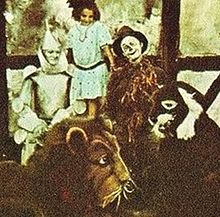
A rediscovered still from the film.
Before the widely-known 1939 film adaptation of The Wizard of Oz, there were numerous attempts to bring L. Frank Baum's classic characters to life. The Fairylogues and Radio-Plays was the earliest-known of these attempts. "Fairylogue" was a play on words of "travelogue", a popular form of documentary at the time which involved people traveling to exotic places. The "radio" part was an attempt to make the film sound "high-tech" much like the word "cyber" would be used in the 90s and early 2000s. This film was actually one of Baum's many ambitious projects, and reportedly one of his last.
The film marks many "firsts". It is the first known film adaptation of Baum's literary works, as mentioned above. It is also one of the first all-color films. It is unknown if it was done through a hand-tinted technique or through early proto-technicolor processes. All that is known is that the color is credited to a "Michael Radio" of Paris, of whom is not at all documented. Whatever Mr. Radio did, he did an amazing job as what can be seen in the above image. The film is also the first film to have an official film score, as it had a small pit orchestra.
Then there comes the real kicker of ambition: this is the first known "interactive" film. Baum and several stage actors would interact with each other on stage as well as onscreen. The film would start out with Baum giving a lecture of his "travelogue" through the Land of Oz and the characters eventually would "pull" him in and then somehow magically work their way out. There was even a scene where Dorothy would be "whisped" away from the stage onto the screen by a tornado. This is considered one of the most technically ambitious pre-1910 films.
The film was shown for two months straight in Michigan and then in New York before closing on December 16, 1908. Despite massive critical acclaim and sold out shows nearly every night it ran, costs were so high that, even though they had doubled the ticket prices, they still couldn't turn a profit. This left Baum depressed for a few years, even up to his death in 1919. Many viewed this as Baum's non-literary masterpiece.
The film was discarded after the Baum estate discovered its decomposition (our good old friend, cellulose nitrate, strikes again) and it is unknown if any other copies survive. When a few production stills were uncovered in the late 80s, historians scrambled to get as much information as possible. The few color images proved to many just how gorgeous the movie was crafted. There have been rumors that a few copies may have been made to sell to collectors via a gift shop at the theater the film was shown. Unless these rumors are true, this film may now be permanently lost.
